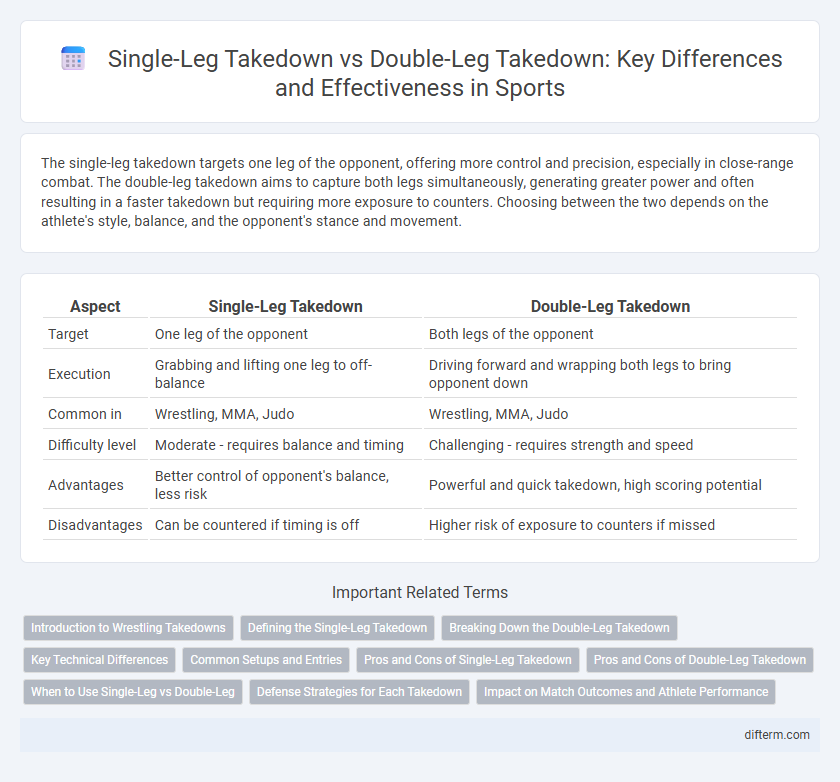The single-leg takedown targets one leg of the opponent, offering more control and precision, especially in close-range combat. The double-leg takedown aims to capture both legs simultaneously, generating greater power and often resulting in a faster takedown but requiring more exposure to counters. Choosing between the two depends on the athlete's style, balance, and the opponent's stance and movement.
Table of Comparison
| Aspect | Single-Leg Takedown | Double-Leg Takedown |
|---|---|---|
| Target | One leg of the opponent | Both legs of the opponent |
| Execution | Grabbing and lifting one leg to off-balance | Driving forward and wrapping both legs to bring opponent down |
| Common in | Wrestling, MMA, Judo | Wrestling, MMA, Judo |
| Difficulty level | Moderate - requires balance and timing | Challenging - requires strength and speed |
| Advantages | Better control of opponent's balance, less risk | Powerful and quick takedown, high scoring potential |
| Disadvantages | Can be countered if timing is off | Higher risk of exposure to counters if missed |
Introduction to Wrestling Takedowns
Single-leg takedowns target one leg of the opponent, emphasizing balance disruption and precise grip control to execute a swift trip or lift. Double-leg takedowns involve securing both legs, generating powerful forward momentum to drive the opponent to the mat with control. Mastery of these foundational wrestling takedowns enhances offensive versatility and sets the stage for effective pinning strategies.
Defining the Single-Leg Takedown
The single-leg takedown targets one of the opponent's legs by securing it either above or below the knee to destabilize their base and bring them to the mat. This technique emphasizes speed, precise grip control, and proper angling to avoid counters and maintain balance. Compared to the double-leg takedown, the single-leg involves less exposure of the attacker's upper body, increasing its effectiveness in close-quarters wrestling and mixed martial arts.
Breaking Down the Double-Leg Takedown
The double-leg takedown involves lowering level, driving forward, and securing both legs to control and bring down the opponent, making it a powerful and versatile move in wrestling and MMA. Unlike the single-leg takedown, which targets one leg, the double-leg takedown maximizes leverage and balance by attacking both legs simultaneously, increasing the likelihood of a successful takedown. Proper technique in penetration step, head positioning, and explosive drive are critical for executing an effective double-leg takedown.
Key Technical Differences
The single-leg takedown targets one leg of the opponent, requiring quick penetration and strong grip control to off-balance them with a sweeping motion. In contrast, the double-leg takedown involves shooting in on both legs simultaneously, emphasizing explosive forward drive and effective head positioning to disrupt the opponent's base. Mastery of level change, hip positioning, and hand placement distinguishes the technical execution of these two fundamental wrestling takedowns.
Common Setups and Entries
Common setups for single-leg takedowns include controlling the opponent's lead leg by using foot sweeps, level changes, and misdirection to create openings, emphasizing speed and precision. Double-leg takedown entries often focus on explosive penetration steps, driving through the opponent's hips while securing both legs for maximum control and leverage. Both techniques rely heavily on effective hand positioning, timing, and maintaining a low center of gravity to execute successful takedowns in wrestling and MMA.
Pros and Cons of Single-Leg Takedown
The single-leg takedown offers greater control on one side of the opponent's body, making it effective for isolating a leg and minimizing exposure to counterattacks. It requires less commitment and is quicker to execute than a double-leg takedown, allowing for faster transitions and easier escapes if the attempt fails. However, the single-leg takedown can be less powerful and more vulnerable to counter-defense like sprawling or whizzers compared to the more forceful and stable double-leg technique.
Pros and Cons of Double-Leg Takedown
The double-leg takedown offers superior control and power by targeting both legs, enabling wrestlers to drive through their opponent effectively and score points quickly. However, it exposes the attacker to counterattacks such as sprawls and guillotine chokes, making timing and technique crucial to avoid vulnerability. Its effectiveness decreases against opponents with strong lower body defense or quick lateral movement, highlighting the need for strategic setup and transition options.
When to Use Single-Leg vs Double-Leg
The single-leg takedown is ideal when an opponent's weight is shifted onto one leg or when access to one leg is more secure, allowing for controlled balance disruption and agility in transition. The double-leg takedown excels in situations where the opponent is in a low stance or advancing aggressively, enabling powerful penetration through their center of gravity for a rapid and forceful bring-down. Understanding the opponent's position, balance, and movement dynamics is crucial for selecting the most effective takedown technique in wrestling and mixed martial arts.
Defense Strategies for Each Takedown
Defending a single-leg takedown requires strong sprawl techniques, maintaining a low center of gravity, and controlling the opponent's head or arm to prevent execution. Against a double-leg takedown, effective defense emphasizes sprawling with hips dropped, wide leg positioning for stability, and using underhooks or cross-face grips to disrupt the attacker's momentum. Developing quick reflexes and anticipating the wrestler's entry angles enhances defensive success for both takedown types.
Impact on Match Outcomes and Athlete Performance
Single-leg takedowns often offer greater control and positional advantage, resulting in high scoring potential and improved match outcomes by enabling athletes to dictate the pace and maintain balance. Double-leg takedowns typically generate faster and more explosive points, enhancing overall athlete performance by leveraging power and agility to overwhelm opponents quickly. Choosing between techniques depends on the athlete's strengths, with single-leg takedowns favoring strategic positioning and double-leg takedowns maximizing speed and force in competitive matches.
single-leg takedown vs double-leg takedown Infographic

 difterm.com
difterm.com